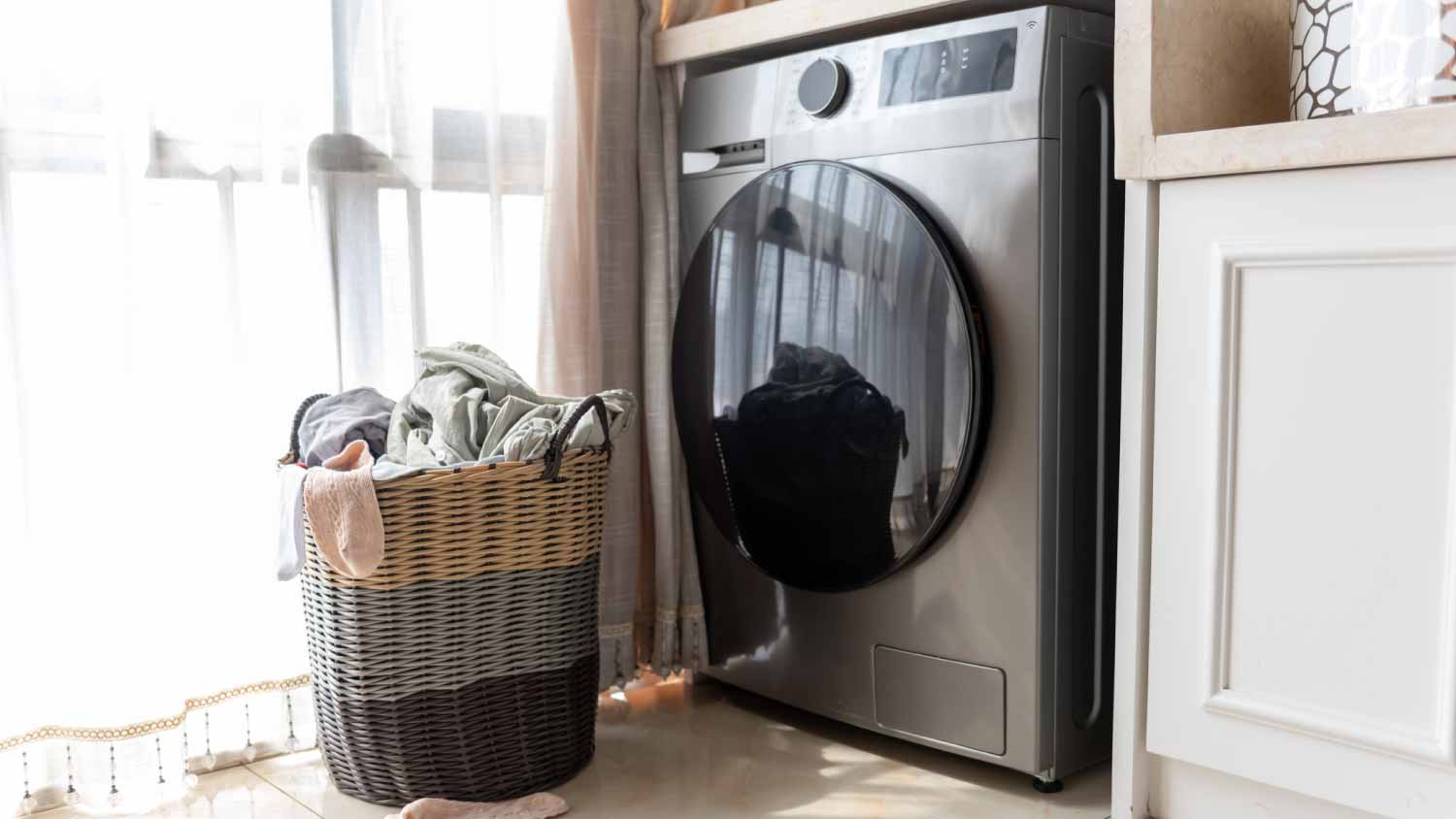11 Tips for Maintaining a Front-Load Washing Machine
Keep your front-load washer spinning for years with these simple maintenance tips


Your high-efficiency front-loader might very well be your family’s best friend. It washes everything from dirty soccer jerseys to bedding and saves on energy costs while doing it. But to keep your washing machine running at its prime, you'll need to perform regular maintenance. Front-loaders use less water than top-loaders, so they're more prone to mold and mildew build-up.
With proper front-load washer maintenance, you can help your machine efficiently power through daily laundry and last its full lifespan (usually up to 10 years). Follow these steps to maintain, clean, and inspect your machine.
1. Wipe Down Your Machine After the Day’s Use

A quick wipe down of your machine at the end of the day’s wash can keep your machine squeaky clean and laundry from dragging across any stagnant or greasy residue. When dirt and moisture get trapped, mold begins to grow. Soaking up excess liquid or moisture is the key to preventing mold and mildew inside your machine.
Dry these parts with a towel or a soft, absorbent cloth after using the washer:
Inside the door gaskets and edges
The backside of the gaskets from top to bottom (peel back rubber seal gently and dry the grooves and drain holes)
The inside door glass and around the opening
The washer drum if there is residual water or moisture
2. Clean Your Machine Monthly
You should clean your front-load washing machine once a month to prevent mold, mildew, and other residue from building up. A few mold spores can multiply exponentially, so it’s best to perform proactive monthly maintenance. Set yourself a monthly calendar reminder to clean and care for your machine, and follow this routine to keep it running free of issues:
Run your washing machine's clean cycle per instructions.
Scrub the door's rubber seal and gasket with an old toothbrush or scrub brush dipped in a mixture of baking soda and vinegar (1-to-2 ratio). Remove any debris and rinse with water afterward.
If you suspect mildew, pour 2 cups of distilled white vinegar into the detergent dispenser and 1 cup of baking soda into the drum. Run the machine on a hot cycle with an extra rinse. This neutralizes the pH and provides scrubbing action.
If you still sense mold or mildew in your machine, mix bleach and water in a container (2 tablespoons of bleach per 1 quart of water). Dip an old toothbrush or scrub brush into the mixture and scrub mildew spots, such as underneath the gasket. Clean your machine with at least two empty hot water cycles to remove the bleach.
If there's residue on your drum from soiled items, wipe it down with a non-abrasive household cleaner or a 1-to-1 vinegar and water solution.
Clean your drain pump filter by removing debris, hair, and fabric to allow maximum water flow. Refer to your manual for cleaning instructions.
Open or take out your detergent drawer and clean the compartments with warm water and dish soap (or vinegar) to remove residue.
Wipe down the drum with a towel to remove moisture.
3. Use High-Efficiency Powder Detergent Only
Only put high-efficiency powder detergent in your machine, as other detergents can cause damage and prevent it from washing and rinsing your clothes thoroughly. In some cases, using improper detergent can even void your machine’s warranty.
Other detergent types, like regular and high-efficiency compatible detergents, can create too many suds and often leave a slimy film inside your machine. Even high-efficiency liquid detergent may leave a film on the machine’s drum that can lead to mold.
High-efficiency powder detergent produces fewer suds and doesn't leave a residue. For optimal front-load washing machine performance, use the amount recommended by your detergent—yes, 1 or 2 tablespoons is enough. Adding too much detergent can leave your clothes and your machine with soap residue.
4. Skip the Liquid Fabric Softener
Forego using fabric softeners in your front-loading machine because it can create a film in your machine—allowing it to trap more lint and mildew. Instead, soften your clothes and sheets with dryer sachets or fabric-softeners for the dryer.
5. Don't Overload Your Machine
Stuffing your front-loader with clothes or bed sheets might seem efficient, but over time, it can wear out your machine. Not to mention, your items won't clean as well since they need space to tumble around. Aim to fill your front-loader no more than 80 percent full. Wash larger items like a comforter or rug separately from clothes so they have room to spin during the cycle.
6. Choose the Right Spin Cycle
Always select the appropriate cycle type for your load, even if it takes longer than a different cycle. Using the wrong cycles causes extra wear and tear on your machine’s internal parts and reduces its lifespan.
7. Remove Your Finished Loads Immediately
Don’t let your damp laundry sit in your machine. The dampness creates a breeding ground for mildew and musty smells in your machine. If you can’t take your clothes out right away, use the delay feature to set the finishing time to when you can transfer everything to the dryer.
8. Leave the Door Open After the Wash
Once you’re done with a load of laundry, leave the door ajar. This allows the machine to air out, preventing mold and mildew growth.
Your machine may have a vent latch that allows the door to remain open a few inches but stay secured to the machine. The latch can prevent small children or pets from climbing into the machine and keep the door from swinging out into the middle of your room. If you don't have a latch or you're concerned about safety, keep your washer door open for at least 30 minutes after the wash, then close it.
9. Keep Your Front-Loader Level
Because your front-load washing machine has an electronic control board, it needs to be level to function properly. If it becomes unbalanced, it throws off the wash cycle, and your machine has to work hard to try and recalibrate.
Load items loosely into your front-loader without overfilling it. If your load is unbalanced, your machine will create noise, movement, and vibration when running. Stop the cycle and readjust or rebalance your items. You can also recalibrate the machine according to its manufacturer’s instructions. Taking these steps to rebalance the front-loader will prevent it from prematurely wearing out.
You should level your machine during setup and check it at least twice a year to ensure it remains balanced. If you notice unusual noises or movement, it's also a good time to re-check it.
10. Opt for Braided Stainless Steel Hoses
Replace the rubber hoses that likely came with your washing machine with braided stainless steel hoses. They cost a bit more but last a lot longer and are less likely to split open. Durable hoses reduce the likelihood of leaks and water catastrophes.
11. Inspect Your Machine Once a Year
Annual front-load washer maintenance and inspection can keep your machine running smoothly and at optimal capacity. You can do the yearly check yourself in about 15 minutes with these steps:
Inspect your washing machine hoses for leaks and loose connections
Check the door seal, gasket, and drum for stains, mildew, and foreign objects.
Smell your machine to see if you notice any musty smells
If you hear loud noises or notice extra movement or water dripping from the base of your machine, it’s best to contact a local washing machine repair professional right away to inspect the issue. Waiting even a few loads after spotting a washing machine repair sign can cause permanent damage to your front-loader.



.jpg?impolicy=leadImage)

- Appliance Repair Companies
- Washing Machine Repair
- Dryer Repair
- Refrigerator Repair
- Dishwasher Repair
- Oven Repair
- Wood & Pellet Stove Repair
- Freezer Repair Services
- Wood Stove Services
- Gas Stove Repair
- Emergency Appliance Repair Companies
- Ice Maker Repair
- Gas Appliance Repair
- GE Appliance Repair
- GE Refrigerator Repair
- GE Dryer Repair
- GE Dishwasher Repair
- GE Washing Machine Repair
- Samsung Appliance Repair
- Samsung Refrigerator Repair
- Samsung Dryer Repair
- Samsung Washer Repair
- Samsung Dishwasher Repair
- Samsung Oven Repair
- Whirlpool Repair
- Whirlpool Refrigerator Repair
- Whirlpool Washer Repair
- Whirlpool Dryer Repair
- Whirlpool Oven Repair
- Maytag Appliance Repair
- Maytag Refrigerator Repair
- Maytag Washer Repair
- Maytag Dryer Repair
- Maytag Dishwasher Repair
- Kitchenaid Appliance Repair
- Kitchenaid Oven Repair
- Kitchenaid Refrigerator Repair
- Kenmore Appliance Repair
- Kenmore Dishwasher Repair
- Kenmore Washer Repair
- Kenmore Dryer Repair
- LG Refrigerator Repair
- Bosch Appliance Repair
- Kenmore Refrigerator Repair
- LG Appliance Repair Services
- GE Microwave Repair
- Electrolux Appliance Repair
- Electrolux Washer Repair
- Kitchenaid Dishwasher Repair Services
- Wood Stove Inspection
- Dishwasher Installation
- Trash Compactor Repair
- How Long Do Washing Machines Last? Here’s the Average Lifespan
- Here Are All the Parts of a Washing Machine—and What Each One Does
- What to Do About Hard Water in Your Washing Machine
- How to Fix Frozen Washing Machine Pipes
- What to Know About Washing Machine Drain Code Requirements
- How Much Detergent to Use to Keep Your Washer Running Safely
- How to Clean Your Laundry Room: An Easy Laundry Room Cleaning Checklist
- Washing Machine Not Agitating? Here’s How to Fix It
- 35 Ways to Prepare Your House for Holiday Vacation [+ Free Checklists]
- 9 Tips for Preventing Mold After Water Damage










